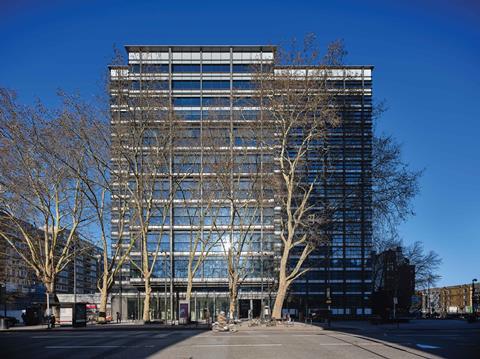Ike Ijeh looks at the contenders for �ڶ����� magazine’s awards for refurbishment, from the world’s most famous opera house to an independent school, highlighting projects that offer sensitive and deferential restorations.
Read: �ڶ����� Awards 2019 Refurbishment Project of the Year shortlist

Moretown �ڶ����� 6, London
- Architect: Gensler / KDS Associates
- Client: Resolution Property
- Contractor: Galliford Try
- Submitted by: Resolution Property
Gensler is an architectural practice renowned for its extensive work in office interiors. Therefore the project to design the interior of the firm’s own office provides a fascinating opportunity to see how the company applies its fit-out design principles to its workplace. The final execution does not disappoint. Comprehensively refurbishing both the interior and exterior of what was formerly an anodyne glass-tinted 1990s office block, the project sees a more legible and transparent exterior skin applied over an extensively reworked open-plan interior arranged around a new atrium, breakout spaces, meeting rooms and a new glazed attic, primarily finished with warm yet robust cross-laminated timber surfaces.

Pennington Street Warehouse, London
- Architect: JTP
- Client: JTP
- Contractor: Construction & Management
- Submitted by: JTP
An architect’s practice occupying a converted warehouse may not be the most uncommon of building types but it is rarely achieved with as much nuanced panache as is the case at JTP’s new east London warehouse. The formerly derelict warehouse once held an electrical substation that powered the printing presses of local Wapping newspaper headquarters. But it has now been transformed into a vibrant workplace where new interventions reflect and enhance the building’s core heritage character. Exposed brickwork has been retained and repaired, new stairs and railings evoke the building’s former industrial character, and the ambitious removal of the ground-floor slab from the new atrium has created a dramatic triple-height entrance volume that acts as the office’s social hub.

Bracken House, London
- Architect: John Robertson Architects
- Client: Obayashi Corporation
- Contractor: McLaren
- Submitted by: John Robertson Architects
Refurbishing one of the City of London’s seminal heritage office buildings after a previous showcase refurbishment that took place just 30 years ago is no easy feat. But the latest renovation of Bracken House executes this revamp with a combination of deference and diligence. The 1950s building retains much of the high-tech industrial character that Hopkins famously applied to it in the late 1990s, but this intervention seeks to protect this heritage while improving circulation and legibility throughout the building. Measures to realise this include a pair of new lightwells that help rationalise the level changes and access between Hopkins work and the original building, alongside a generous roof terrace offering key amenity space and a stunning view of the adjacent St Paul’s cathedral.

LABS House, London
- Architect: Od Interiors
- Client: LabTech
- Contractor: Od Group
- Submitted by: Od Interiors
This project sees the comprehensive development of a nine-storey neo-Georgian office block near the British Museum. While the heritage exterior has been retained untouched, the interior sees the insertion of a 80,000ft² workspace providing workplaces for almost 2,000 people. In order to ensure the project could be distinguished from the swathe of similar office refurbishments in the Holborn area, the scheme sees the adoption of a number of key physical and functional innovations. These include new feature lighting, a standalone MEP system, internal Crittall Windows partitions, bespoke joinery, stone floor finishes, co-working spaces, a gym, a restaurant and a bar.

The Bower, London
- Architect: AHMM
- Client: Helical
- Contractor: Sisk / Skanska
- Submitted by: AHMM
AHMM has acquired a forte in developing pioneering office designs, and its landmark White Collar Factory helped kickstart modern office trends that have reinvented the contemporary workplace as a stripped-back, flexible and sociable environment inspired by industrial efficiency. Now, across the road at the Bower, this manifesto has been applied to the trickier challenge of refurbishing an existing building rather than constructing it from scratch, a task made more onerous by that fact the original building was a pair of belligerent, oversized and contextually incongruous 1960s glass and concrete slabs. Now these have been comprehensively transformed by a new external facade, complete with a new footprint to break the monotony of the original elevation. Interiors have also been laid bare to the concrete floor and suspended ceilings removed to create a new workplace of discreet services and streamlined office spaces.

Wellington Wimbledon, London
- Architect: MATT Architecture
- Client: Threadneedle Pensions
- Contractor: ISG
- Submitted by: TFT (project manager)
Prior to refurbishment, Wellington House was like any number of innocuous, anodyne office blocks found in town centres up and down the land. But a clever refurbishment plan has seen the building completely remodelled and reorganised inside and out and has increased net internal area by 2.5 times with only one additional storey added. This has been achieved by stripping back the building to its structural frame and creating a dynamic new red brick and green ceramic facade designed as a contemporary solution that gels with the heritage characteristics of the local Wimbledon townscape. Internally revamped office spaces use underfloor heating to maximise floor-to-ceiling heights and benefit from reconfigured circulation spaces that increase usage and efficiency.


























No comments yet